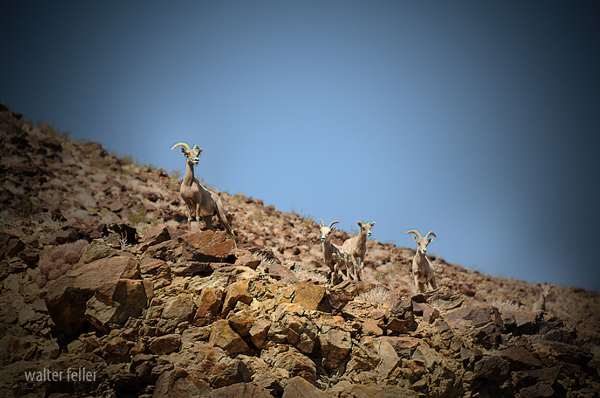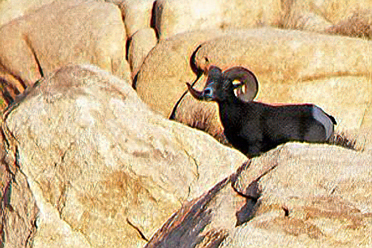Bighorn Sheep
Ovis canadensis
Family: Bovidae
Order: Artiodactyla
Class: Mammalia
Distribution and Subspecies
Bighorn sheep are relatively rare in California, and three subspecies are represented:California Bighorn Sheep (O. c. californiana): Inhabit the southern Sierra Nevada; herds, such as the Mt. Baxter and Mt. Williamson groups, are used for reintroduction stock in other locations.
Peninsular Bighorn Sheep (O. c. cremnobates): Occur in the Peninsular Ranges, from Riverside County south into Mexico.
Nelson Bighorn Sheep (O. c. nelsoni): Desert bighorns inhabit desert mountain ranges from Mono County to the Mexican border, including isolated populations in the San Gabriel Mountains.
Habitats
They can be found in these diverse habitats:Specific Habitat Needs
FeedingBighorn sheep graze on grasses, forbs, and browse, especially in arid habitats. Mineral licks may be crucial for nutrition for some populations.
Cover
Steep, rocky terrain provides cover from predators and is used as a bedding area.Reproduction
Lambing occurs on steep slopes and in canyons to reduce predation.Water
In arid environments, water sources, such as springs, depressions, or man-made structures, are critical.Seasonal Movements
Desert bighorns move between summer mountain areas and winter canyon areas, staying close to water when it is hot.Home Range
Their ranges include summer and winter homes and the paths between them. Desert sheep usually have smaller ranges in summer because they need water.Reproduction
Threats and Conservation Status
DiseaseHighly susceptible to diseases such as pneumonia, frequently brought in by domestic livestock, which can decimate populations. Competition
Feral ungulates and domestic livestock compete with bighorns for water and forage, risking bighorn survival. Predation
Small populations, especially new transplants, are vulnerable to predation. Habitat Loss
Loss of critical habitats, such as feeding, lambing, or escape terrain, would seriously jeopardize the stability of a population.
By knowing these needs and threats, conservation can be more specifically designed to assist bighorn sheep populations better.
Archive

Bighorn Sheep
Bighorn Sheep (Ovis Canadensis) are beautiful and majestic creatures, with rams having large brown horns curling around, under and forward. They are typically found in the higher elevations near water sources or rocky cliff areas. They eat grasses and other plants. Bighorn Sheep have hooves adapted to steep, rocky terrain and use their climbing abilities to escape predators.
More about Bighorn Sheep
Weight: 115-280 lbs.Length with tail: 50-62"
Shoulder Height: 32-40"
Sexual Maturity: 2 years
Mating Season: Nov.-Dec.
Gestation Period: 180 days
No. of Young: 1-2
Birth Interval: 1 year
Lifespan: Bighorns can live 10 to 15 years
Typical diet: mainly grasses, sedges and forbs.
|
The Desert Food Chain * Everything has its niche. Who eats what, and what eats who in the desert? Click here to find out what more. |